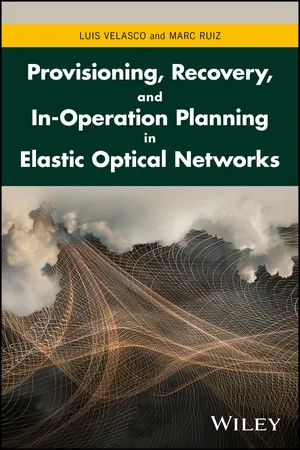
Provisioning, Recovery, and In-Operation Planning in Elastic Optical Networks
- English
- ePUB (mobile friendly)
- Available on iOS & Android
Provisioning, Recovery, and In-Operation Planning in Elastic Optical Networks
About this book
Explains the importance of Elastic Optical Networks (EONs) and how they can be implemented by the world's carriers
This book discusses Elastic Optical Networks (EONs) from an operational perspective. It presents algorithms that are suitable for real-time operation and includes experimental results to further demonstrate the feasibility of the approaches discussed. It covers practical issues such as provisioning, protection, and defragmentation. It also presents provisioning and recovery in single layer elastic optical networks (EON). The authors review algorithms for provisioning point-to-point, anycast, and multicast connections, as well as transfer-based connections for datacenter interconnection. They also include algorithms for recovery connections from failures in the optical layer and in-operation planning algorithms for EONs.
Provisioning, Recovery and In-operation Planning in Elastic Optical Network also examines multi-layer scenarios. It covers virtual network topology reconfiguration and multi-layer recovery, and includes provisioning customer virtual networks and the use of data analytics in order to bring cognition to the network. In addition, the book:
- Presents managing connections dynamically—and the flexibility to adapt the connection bitrate to the traffic needs fit well for new types of services, such as datacenter interconnection and Network Function Virtualization (NFV)
- Examines the topic in a holistic and comprehensive way, addressing control and management plane issues for provisioning, recovery, and in-operation planning
- Covers provisioning, recovery, and in-operation planning for EONs at the proposed exhaustive level
The rapid expanse of new services has made the use of EONs (a relatively new concept) a necessity. That's why this book is perfect for students and researchers in the field of technologies for optical networks (specifically EONs), including network architectures and planning, dynamic connection provisioning, on-line network re-optimization, and control and management planes. It is also an important text for engineers and practitioners working for telecom network operators, service providers, and vendors that require knowledge on a rapidly evolving topic.
Frequently asked questions
- Essential is ideal for learners and professionals who enjoy exploring a wide range of subjects. Access the Essential Library with 800,000+ trusted titles and best-sellers across business, personal growth, and the humanities. Includes unlimited reading time and Standard Read Aloud voice.
- Complete: Perfect for advanced learners and researchers needing full, unrestricted access. Unlock 1.4M+ books across hundreds of subjects, including academic and specialized titles. The Complete Plan also includes advanced features like Premium Read Aloud and Research Assistant.
Please note we cannot support devices running on iOS 13 and Android 7 or earlier. Learn more about using the app.
Information
1
Motivation
1.1 Motivation
- Liquid Crystal on Silicon (LCoS)‐based Wavelength Selective Switches (WSS) to build flexgrid‐ready Optical Cross‐Connects (OXCs) [Ji09].
- The development of advanced modulation formats to increase efficiency, which are capable of extending the reach of optical signals [Ge12].
- Sliceable Bandwidth‐Variable Transponders (SBVTs) able to deal with several flows in parallel, thus adding, even more, flexibility and reducing costs [Sa15].




| WDM | EON | ||
| Number of IP/MPLS areas | 1... |
Table of contents
- Cover
- Title Page
- Table of Contents
- List of Contributors
- 1 Motivation
- Part I: Introduction
- Part II: Provisioning in Single Layer Networks
- Part III: Recovery and In‐operation Planning in Single Layer Networks
- Part IV: Multilayer Networks
- Part V: Future Trends
- List of Acronyms
- References
- Index
- End User License Agreement